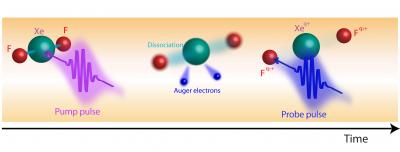New X-ray method allows scientists to probe molecular explosions

A team led by researchers from the Argonne National Laboratory used the high-intensity, quick-burst X-rays provided by the Linac Coherent Light Source (LCLS) at SLAC National Accelerator Laboratory to look at how the atoms in a molecule change when the molecule is bombarded with X-rays. This schematic shows the dissociation of a xenon difluoride molecule during the X-ray pump/X-ray probe process. Credit: Antonio Picon
A team led by researchers from the U.S. Department of Energy's Argonne National Laboratory used the high-intensity, quick-burst X-rays provided by the Linac Coherent Light Source (LCLS) at SLAC National Accelerator Laboratory to look at how the atoms in a molecule change when the molecule is bombarded with X-rays.
“The LCLS gives us a unique perspective on molecular dynamics because of the extremely brief X-ray pulses that we can use,” said Antonio Picon, an Argonne X-ray scientist and lead author. “We're able to see how charge and energy can flow through a system with amazing precision.”
By using a new method called X-ray pump/X-ray probe, the researchers were able to excite a specifically targeted inner-shell electron in a xenon atom bonded to two fluorine atoms. After the electron was excited out of its shell, the unbalanced positive charge in the rest of the molecule caused the molecule to spontaneously dissociate in a process known as “Coulomb explosion.”
“The new X-ray pump/X-ray probe technique is so powerful because it allows us to shake the molecule at one point, and look at how it changes at a second point,” said Argonne X-ray scientist and study author Christoph Bostedt.
The xenon difluoride molecule is only a first step for the technique. In the future, the same X-ray pump/X-ray probe method could find a broad range of applications, such as following the ultrafast structural changes that occur in light-sensitive molecules or the flow of energy in molecules. By understanding intramolecular energy flow, researchers can better develop novel materials to harness the sun's energy, such as photovoltaics and photocatalysts.
The new technique could also help researchers address challenges relating to the protein structure determination. For pharmaceutical studies, X-rays are often used to figure out the structures of proteins, but during that process they can also damage parts of them.
“This technique lets you see how neighboring atoms are affected when certain regions interact with X-rays,” said Stephen Southworth, an Argonne senior X-ray scientist.
By using an X-ray pump to excite one of the innermost electrons in the molecule, the researchers were able to target one of the electrons that is most central to and characteristic of the molecule. “This technique gives us the ability to take a series of quick snapshots to see what happens when we change a fundamental part of a molecule, and what we learn from it can inform how we approach the interactions between light and molecules in the future,” said Picon.
The research, which was funded by the DOE Office of Science, involved a collaboration between Argonne, SLAC, and Kansas State University. “For these kinds of studies, you really need a team that combines world leaders in X-ray sources, particle detection and sample manipulation,” Southworth said.
An article based on the study, “Hetero-site-specific X-ray pump-probe spectroscopy for femtosecond intramolecular dynamics,” appeared in the May 23 online edition of Nature Communications.
###
Argonne National Laboratory seeks solutions to pressing national problems in science and technology. The nation's first national laboratory, Argonne conducts leading-edge basic and applied scientific research in virtually every scientific discipline. Argonne researchers work closely with researchers from hundreds of companies, universities, and federal, state and municipal agencies to help them solve their specific problems, advance America's scientific leadership and prepare the nation for a better future. With employees from more than 60 nations, Argonne is managed by UChicago Argonne, LLC for the U.S. Department of Energy's Office of Science.
The U.S. Department of Energy's Office of Science is the single largest supporter of basic research in the physical sciences in the United States and is working to address some of the most pressing challenges of our time. For more information, visit the Office of Science website.
Media Contact
All latest news from the category: Physics and Astronomy
This area deals with the fundamental laws and building blocks of nature and how they interact, the properties and the behavior of matter, and research into space and time and their structures.
innovations-report provides in-depth reports and articles on subjects such as astrophysics, laser technologies, nuclear, quantum, particle and solid-state physics, nanotechnologies, planetary research and findings (Mars, Venus) and developments related to the Hubble Telescope.
Newest articles

A ‘language’ for ML models to predict nanopore properties
A large number of 2D materials like graphene can have nanopores – small holes formed by missing atoms through which foreign substances can pass. The properties of these nanopores dictate many…

Clinically validated, wearable ultrasound patch
… for continuous blood pressure monitoring. A team of researchers at the University of California San Diego has developed a new and improved wearable ultrasound patch for continuous and noninvasive…

A new puzzle piece for string theory research
Dr. Ksenia Fedosova from the Cluster of Excellence Mathematics Münster, along with an international research team, has proven a conjecture in string theory that physicists had proposed regarding certain equations….



